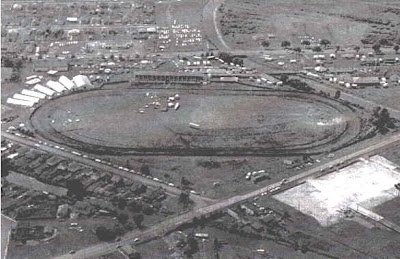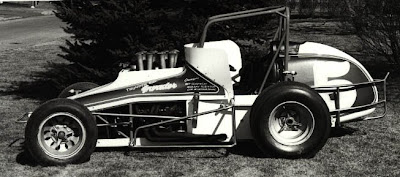Ever since Riverview closed in the summer of 1993 there would be rumour's of its re-opening. In the fall of 1999 there was actually some truth to it,a handshake deal was reached to purchase Riverview from Bowater with the words "it looks like you've bought yourself a racetrack" being spoken. There was objection to it by residents near the track calling themselves TBROAR,I found most of their objection's were (as usual) lacking fact and wrote the following letter to the Chronicle Journal refuting the claims.
The Chronicle unfortunately did not run my letter,here it is in its entirety.
October 2/99
Another Point of View, Re: Riverview Raceway
Having read the various letters on the re-opening of Riverview Raceways, I find the opposition is based more so on a “Not in my neighborhood ” attitude than on actual facts. In particular, reasons for opposition to the facility presented by Ken & Karen Cocks, and their group TBROAR, are misleading, inaccurate, and based without any presented fact(s). In their letter of September 11/99,the Cocks state, they are opposed for “obvious reasons - noise, dust, Increased traffic on Hwy 61,spillage of gasoline, oil and antifreeze into the bordering Kam River.Consider the following facts, 1/ Dust can be kept to an acceptable minimum through proper track preparation, with the track thoroughly watered for a night of racing. This not only keeps the dust down,but also makes for better racing. 2/The noise problem is probably the biggest concern, consider the following, the state of California has the strictest noise laws in the USA, through the use of mufflers, and enforced curfews of generally 11pm,several tracks exist in area’s close to residential areas. For example, tracks in San Jose CA, Chico CA, the former Ascot Park in Los Angeles, and the new Irwindale Speedway, both track and residents co-exist in harmony. Most nights, Riverview started with warm-ups at about 7:00 pm, with the races over by 10:30 pm, a 3 &1/2 hour period. This was not a steady period of on the throttle racing, there was breaks between races, as well as an intermission, is this time period too much to ask for in a week of 168 hours? 3/ The increased traffic on Hwy 61 was directed most race nights by a police officer, this made the exiting from the track orderly & efficient. Is the traffic flow from other local venues, such as the Auditorium, Ft. William Gardens etc handled in this fashion? While a tragedy did occur on Hwy 61,it is not the fault of the track that a fan chooses to drive recklessly after leaving the facility. 4/ Regarding the spillage of gasoline. Most race cars do not operate on gasoline, but use Methanol. Most race cars use very little, if any anti-freeze. As for motor oil it must be disposed of in proper containers provided at the track, this is enforced by the Ministry of the Environment. There is some spillage though, when an engine blows, though it would not be considered an environmental hazard. There has never in the years of the tracks operation been an environmental hazard that I am aware of. Can the Cocks present evidence of one? 5/ The Cocks state concern about disturbing the wildlife at the nature preserve, is the operation of motorboats down the river not disturbing? Is this to suggest that perhaps this activity should be outlawed also? 6/ The Cocks state that the re-opening of Riverview will lower proper values in surrounding developments. Most of these were being developed while Riverview was still operating. I find it quite a stretch that with two major industries (Bombardier & Bowater),two major rail lines, and an airport in close proximity that a race track operating less than 10 hours a week, over 3 1/2 to 4 months would actually affect any property values. This seems more like fear mongering than anything, if the Cocks can provide facts, please do. Their are many residents of these developments that are in favour of Riverview’s revival. Also, how many of the opposed purchased their homes while Riverview was in operation. If so opposed, why would you have bought in that location then? 7/ The Cocks also state that “It is not the big time racing, money drivers and fans you see on tv.” Is this to suggest that unless something is “big-time” that we should not support it? Is that not the attitude that sent the Thunder Cats and Whiskey Jacks packing? Through the years top USA drivers that have appeared include,1949 Indianapolis 500 winner Bill Holland, Four time IMCA National Champion Bobby Grimm, Jerry Richert who was also a Four time IMCA National Champion was a regular competitor at the CLE in the 60’s,as well as Riverview in the 70’s,Doug Wolfgang, arguably one of the greatest sprint car racers of all time raced at Riverview in 1976,these are just a few. Over the past 30 years Tom Nesbitt has dominated the upper mid-west US in the Late Model class winning over 30 track titles, Joel Cryderman is a top Late Model racer in this area today. Both Lyn McIntosh and the late Barry Kettering were champions in the sprint cars of the Midwest Sprint Association in the 70’s. Perhaps this is not “big-time” enough to the Cocks, but it sure is to those who enjoy and know racing. 8/ Despite the hard work of many, as well as good racing, Mosquito has not been the more practical location for racing that they suggest. As with any business, location is the most important factor, car counts as well as attendance has thus suffered with Mosquito’s location. The Cocks ask the question, ”Why should we as property owners bear the blunt discrimination of this so-called automotive opportunity?” Is this not a prime example of the “Not in my neighborhood ” attitude that has derailed so many other ventures that the city and area would have benefited from? Is the ”Not in my neighborhood” attitude of the Cocks and their group TBROAR not “Blatant discrimination” against those who enjoy racing? In the years of its operation, Riverview operated responsibly as a member of the community,and their are no indications that would suggest those re-opening it would operate otherwise. While the Cocks consider Riverview something they do not want in their neighborhood, have they ever attended events at Ft.William Gardens, the CLE, Community Auditorium, P.A. Stadium, etc. I’m certain that some residents in these neighborhood’ s wish these facilities were not in their neighborhood, but they live with them and do not try to deprive those who enjoy these facilities the pleasure they find there. Consider these other facts, 1/ Since first appearing on the local sport scene in the late teen’s, racing has paid its own way, never using taxpayer funds to aid in its operation. While the first few races were merely exhibitions as part of the local fair, racing has otherwise been ran and organizied, by clubs, such as the Twin Cities Motor Contest Association in the 20’s & 30’s , the Lakehead Stock Car Club in the 50’s & 60’s,Thunder Bay Dirt Track Association, or by private operators such as Riverview & Mosquito’s builders were. These groups were and have been responsible for the maintenance and improvement of the track(s) they used, without any use of taxpayers money. Certain cultural entities locally have received local or provincial tax dollars to aid them, racing never has, or will. 2/ Riverview is built on private property, thus paying property taxes, its rebuilding and maintenance will also be done with private money. Nearly all other local sports, as well as cultural entities operate in publicly owned and operated facilities, generating no property taxes, built by and maintained with public funds. Racing contributes to the community economically as well, consider the result of a 1985 study done by the state of Maryland. The study concluded that Hagerstown Speedway, a 1/2 mile dirt track, located near Baltimore, contributed $7,000,000 to the state economy. While this figure may be 15 years old, racing has increased in popularity since that time and it demonstrates the kind of impact such a track can have on the local economy. Hagerstown Speedway operates one night weekly with a couple of two day specials during the season. If you figure in inflation, and conversion into Canadian dollars the re-opening of Riverview would certainly have a very positive effect on the local economy even if its crowds were half of Hagerstown.. 3/ All of the competitors are essentially independent operators, funding their race car from their own pockets. Some may think that sponsors pay the costs, not true, sponsorship dollars help but the bulk of funds come from the racers own pockets and prize money won. 4/ Fall races at both the CLE and Riverview attracted competitors and fans from the US, bringing tourist dollars to Thunder Bay. According to Mr Hayward’s letter of Oct.2/99,many have told him they would like to return. With all the public money spent to attract tourist dollars to our area, is it not a bonus to have private money doing it? 5/ Racing takes place ,20% at the professional level,80% at the non-professional level. It is at tracks like Riverview where legends, AJ Foyt, Mario Andretti, Al & Bobby Unser, Richard Petty, etc started their careers. Today’s new stars, Jeff Gordon and Tony Stewart also started their careers on these tracks. 6/ From the local tracks to the professional level,racing is the last sport where true sportsmanship occurs. It is a very common site for competitors to help one another repair their car or lend parts so they can return to competition. There are many rumours to the proposed use of the Riverview property for non-racing activities, more along the lines of recreational use. If this is true, would it be wise to discourage private funding of such a facility, rather than depend on tax dollars to do the same. Names I’ve heard associated with Riverview are those of racing people, and I doubt that without the track running, any other recreational development on the site would take place. Certainly the Cocks & TBROAR are entitled to present their opinions, but please present facts. Better yet, come out to the races and see what good people racers are, and the great entertainment they provide. I am in full support of the re-opening of Riverview, and am certain that it will present the same or even better quality entertainment than it did in its previous existence. Hopefully it will come to fruition.











































